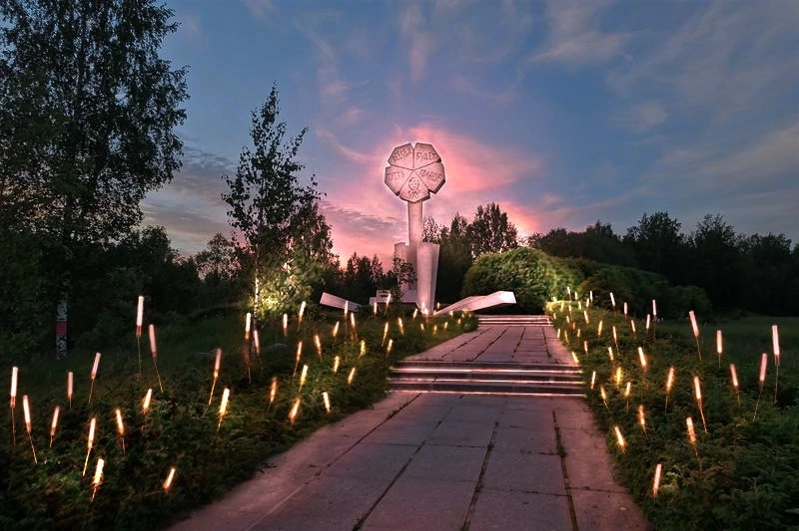The Committee for Urban Development Policy of the Leningrad Region held a competition to create an architectural concept for the comprehensive modernization of the “Road of Life” memorial landscape complex. The project of the SPbGASU team was recognized as the first stage winner.
The head of the winning project, senior lecturer at the SPbGASU Department of Architectural and Urban-Plannning Heritage, Daria Bobrova, reminds that the concept of modernizing the historical complex is focused on the goal of restoring the memorial function of the monuments of the Road of Life.
“Currently, the main problem of the Road of Life as a memorial complex is the fragmentation of objects, the lack of perception of them as parts of a common, unified structure, as a result of which the monuments are neglected and absorbed by the natural environment. The proposed transformations contribute to the formation of a single path on the Road of Life, a spatial corridor that corresponds to the current stage of development of architectural trends and unites existing monuments into a single memorial complex that corresponds to the scale of the feat accomplished on the Road of Life during the war years,” explained Daria Bobrova.
According to her, the concept is based on a symbolic approach: unity, feat, memory, hope - words that reflect the very image and essence of the Road of Life, which arose from the moment of its foundation, developed over time and transformed into its modern state. The entire concept of the memorial complex is built on their basis. First, it is transformed into a logo, which sets the tone for the entire accompanying identity, then it is reflected in the volumetric-spatial solutions of both individual objects and their elements, and the entire complex as a whole. Thus, each proposed transformation forms a connection with existing monuments at a deep, semantic level, being a delicate addition to the fine existing structure of the complex, preconditioning its restoration and life.
“Comprehensive landscaping, which creates conditions for updating the monuments of the Road of Life, presupposes the variability of public transport stops: two types of stops have been developed. The design was based on the idea of a logo and general identity. According to the concept, each memorial site, as well as public transport stops and small architectural forms, have individual lighting, providing for variability in the nature of the illumination. Thus, on dates commemorating the Road of Life, the strict, laconic lighting at each memorial site, bus stops and noise barriers is replaced with red. In the general style, it is proposed to create small architectural forms: benches, navigation stands, trash cans, noise screens,” added Daria Bobrova.
As the senior lecturer reported, the project also provides for the creation of a tourist information center - one of the first objects that meet a person on the way along the Road of Life. Its functional content is dictated by the need to tell about the history of the memorial complex. The image of the object, the volume in the form of a block broken in two, symbolizes the breaking of the blockade, the triumph of the feat of the human spirit, setting up visitors to the memorial complex to perceive the historical monuments located further along the Road and setting the tone for the overall composition of the entire route. In addition, there is a memorial complex provided for those who died on Ladoga Lake, in the form of a mound.
“The mound is an archetypal type of military burial for European and Russian culture, which carries many sacred meanings - going underground into the world of the dead, a circle symbolizing the sun in plan. Since the object is located within the boundaries of the water protection zone of Ladoga Lake, it was appropriate to use the shape of a circle as the purest natural form. The mound is cut through by two long concrete walls, forming a narrow passage into the hall and further through and symbolizing the Road of Life itself, limited on both sides by German and Finnish troops,” said Daria Bobrova. She added that the space between the slabs is covered with durable transparent material so that people can see the composition from above. And those who are inside the hall space will perceive them as walking on the ice of a lake. Inside the memorial space, it is possible to provide an exhibition or panorama dedicated to the Road of Life.
A total of 10 Russian universities took part in the competition. The majority of creative applications came from SPbGASU - the university formed eight teams. Based on the results of the competition, the three best creative teams had the opportunity to finalize their applications and claim the final victory. The results of the second stage are scheduled to be announced on 22 November.“This project is very important for us: it provides an opportunity to touch the great memory of our people. It is very important to continue working and develop each element and detail of the concept in more detail. This will provide an opportunity to popularize and perhaps even implement design solutions,” concluded Daria Bobrova.















